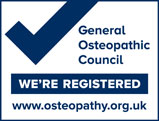Cranial information
At North London Osteopaths Alan Nevies and associates pride themselves on helping patients at all ages and stages of life. People are often surprised that babies and children might require osteopathic treatment, but cranial osteopathy for babies and children involves looking at their unique anatomy.
A baby’s head is significantly different to the adult skull. Their head is made up of 26 small bones. They are free floating bones that are held together on a membrane and are separated from each other by joints of fibrous sutures. These joints are very mobile and are designed to overlap and squash down in order for the baby to be born. Some of these bones are fused later on in life but are not fully fused at birth to allow the head to fit through the birth canal. These unfused bones are therefore subject to strains within them. This happens because every birth is a unique experience for both the mother and baby. A baby has to undergo several twists and turns in different directions in order to leave the birth canal. In addition to this, the labour may have been very fast or very long and drawn out, the baby may have been stuck, had the umbilical cord around its neck or needed assistance with forceps or ventouse . Whilst most babies are able to resolve these stresses and strains through crying and sucking, sometimes the strains can’t fully resolve and a baby may be left feeling uncomfortable and therefore irritable. Cranial osteopaths are trained to recognise any effects caused by these sensations. They release the pressure that builds up, as torsions through these bones can affect the head position and ultimately brain and nerve development. Lots of small nerves called cranial nerves also pass through tiny holes within and between the bones of the head . If one of these nerves becomes irritated it will affect the muscles that are involved with digestion and co coordinating the tongue, both of which muscle groups are necessary for effective latch and feeding technique. As a result the baby can then become irritated and it will struggle to relax, settle and have digestive discomfort.
Cranial osteopathy for children and babies does not hurt as it is extremely gentle. Parents can hold, feed, talk to and even play with children during the session if they want to!
During a cranial osteopathy session, the osteopath will start by asking the guardian questions about the baby, to find out whether it was a good pregnancy and a straightforward birth.
Once they have all that information the physical examination begins. The first thing they do is simply hold the baby gently, feeling for that fundamental subtle movement within all body tissues that cranial osteopaths are trained to feel. They pay special attention to whether that movement is symmetrical or stronger on one side or the other but also whether there are any strains within the bones and joints of the body. The osteopath will then use very gentle pressure to resolve these tensions and strains, helping the baby to feel more relaxed and contented.
The most common difficulties helped by a cranial osteopath are:
- Colic
- Restlessness and irritability
- Reflux/ silent reflux
- Recurrent ear infections
Come and bring your baby and see for yourself at www.northlondonosteopaths.co.uk


